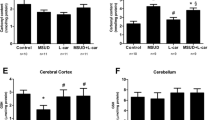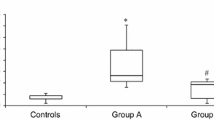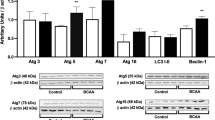Abstract
Maple syrup urine disease (MSUD) is a metabolic disease caused by a deficiency in the branched-chain α-keto acid dehydrogenase complex, leading to the accumulation of branched-chain keto acids and their corresponding branched-chain amino acids (BCAA) in patients. Treatment involves protein-restricted diet and the supplementation with a specific formula containing essential amino acids (except BCAA) and micronutrients, in order to avoid the appearance of neurological symptoms. Although the accumulation of toxic metabolites is associated to appearance of symptoms, the mechanisms underlying the brain damage in MSUD remain unclear, and new evidence has emerged indicating that oxidative stress contributes to this damage. In this context, this review addresses some of the recent findings obtained from cells lines, animal studies, and from patients indicating that oxidative stress is an important determinant of the pathophysiology of MSUD. Recent works have shown that the metabolites accumulated in the disease induce morphological alterations in C6 glioma cells through nitrogen reactive species generation. In addition, several works demonstrated that the levels of important antioxidants decrease in animal models and also in MSUD patients (what have been attributed to protein-restricted diets). Also, markers of lipid, protein, and DNA oxidative damage have been reported in MSUD, probably secondary to the high production of free radicals. Considering these findings, it is well-established that oxidative stress contributes to brain damage in MSUD, and this review offers new perspectives for the prevention of the neurological damage in MSUD, which may include the use of appropriate antioxidants as a novel adjuvant therapy for patients.

Similar content being viewed by others
References
Adibhatla RM, Hatcher JF (2010) Lipid oxidation and peroxidation in CNS health and disease: from molecular mechanisms to therapeutic opportunities. Antioxid Redox Signal 12:125–169
Agarwal A, Said TM (2004) Carnitines and male infertility. Reprod Biomed Online 8:376–384
Aksenov MY, Aksenova MV, Payne RM, Smith CD, Markesbery WR, Carney JM (1997) The expression of creatine kinase isoenzymes in neocortex of patients with neurodegenerative disorders: Alzheimer’s and Pick’s disease. Exp Neurol 146:458–465
Andersen JK (2004) Oxidative stress in neurodegeneration: cause or consequence? Nat Med 10:18–25
Araújo P, Wassermann GF, Tallini K et al (2001) Reduction of large neutral amino acid levels in plasma and brain of hyperleucinemic rats. Neurochem Int 38:529–537
Aruoma OI, Halliwell B, Hoey BM, Butler J (1989) The antioxidant action of N-acetylcysteine: its reaction with hydrogen peroxide, hydroxyl radical, superoxide, and hypochlorous acid. Free Radic Biol Med 6(6):593–597
Barschak AG, Sitta A, Deon M et al (2006) Evidence that oxidative stress is increased in plasma from patients with maple syrup urine disease. Metab Brain Dis 21:279–286
Barschak AG, Sitta A, Deon M et al (2007) Erythrocyte glutathione peroxidase activity and plasma selenium concentration are reduced in maple syrup urine disease patients during treatment. Int J Dev Neurosci 25:335–338
Barschak AG, Marchesan C, Sitta A et al (2008a) Maple syrup urine disease in treated patients: biochemical and oxidative stress profiles. Clin Biochem 41:317–324
Barschak AG, Sitta A, Deon M et al (2008b) Oxidative stress in plasma from maple syrup urine disease patients during treatment. Metab Brain Dis 23:71–80
Barschak AG, Sitta A, Deon M et al (2009) Amino acids levels and lipid peroxidation in maple syrup urine disease patients. Clin Biochem 42(6):462–466
Bertelli A, Conte A, Ronca G (1994) l-Propyonil carnitine protects erythrocytes and low density lipoproteins against peroxidation. Drugs Exp Clin Res 20:191–197
Bessman SP, Carpenter CL (1985) The creatine phosphate energy shuttle. Annu Rev Biochem 54:831–862
Blanc EM, Bruce-Keller AJ, Mattson MP (1998) Astrocytic gap junctional communication decreases neuronal vulnerability to oxidative stress-induced disruption of Ca2+ homeostasis and cell death. J Neurochem 70:958–970
Borglund M, Sjöblad S, Akesson B (1989) Effect of selenium supplementation on the distribution of selenium among plasma proteins of a patient with maple syrup urine disease. Eur J Pediatr 148(8):767–769
Bridi R, Araldi J, Sgarbi M et al (2003) Induction of oxidative stress in rat brain by the metabolites accumulating in maple syrup urine disease. Int J Dev Neurosci 21:327–332
Bridi R, Latini A, Braum CA et al (2005a) Evaluation of the mechanisms involved in leucine-induced oxidative damage in cerebral cortex of young rats. Free Radic Res 39:71–79
Bridi R, Braun CA, Zorzi GK et al (2005b) α-Keto acids accumulating in maple syrup urine disease stimulate lipid peroxidation and reduce antioxidant defenses in cerebral cortex from young rats. Metab Brain Dis 20:155–167
Bridi R, Fontella FU, Pulronik V et al (2006) A chemically-induced acute model of maple syrup urine disease in rats for neurochemical studies. J Neurosci Methods 155:224–230
Brown GC (1999) Nitric oxide and mitochondrial respiration. Biochim Biophys Acta 1411:351–369
Cadenas E, Sies H (1998) The lag phase. Free Radic Res 28:601–609
Castro IP, Martins LM, Tufi R (2010) Mitochondrial quality control and neurological disease: an emerging connection. Exp Rev Mol Med 12:1–21
Chance B, Sies H, Boveris A (1979) Hydroperoxide metabolism in mammalian organs. Physiol Rev 59:527–605
Chuang DT, Shih VE (2001) Disorders of branched chain amino acid and keto acid metabolism. In: Scriver CR, Beaudet A, Sly WL, Valle D (eds) The metabolic and molecular bases of inherited disease, 8th edn. McGraw-Hill, New York
Coitinho AS, de Mello CF, Lima TT, de Bastiani J, Fighera MR, Wajner M (2001) Pharmacological evidence that alpha-ketoisovaleric acid induces convulsions through GABAergic and glutamatergic mechanisms in rats. Brain Res 89:68–73
Cooke MS, Olinski R, Evans MD (2006) Does measurement of oxidative damage to DNA have clinical significance? Clin Chim Acta 365:30–49
De Lima PP, Funchal C, Loureiro SO et al (2007) Branched-chain amino acids accumulating in maple syrup urine disease induce morphological alterations in C6 glioma cells probably through reactive species. Int J Dev Neurosci 25:181–189
Deon M, Wajner M, Sirtori LR et al (2006) The effect of Lorenzo′s oil on oxidative stress in X-linked adrenoleukodystrophy. J Neurol Sci 247:157–164
Derin N, Izgut-Uysal VN, Agac A, Aliciguzel Y, Demir N (2004) l-Carnitine protects gastric mucosa by decreasing ischemia–reperfusion induced lipid peroxidation. J Physiol Pharmacol 55:595–606
Donato R (2001) S100: a multigenic family of calcium-modulated proteins of the EF-hand type with intracellular and extracellular functional roles. Int J Biochem Cell Biol 33:637–668
Donato R (2003) Intracellular and extracellular roles of S100 proteins. Microsc Res Tech 60:540–551
Fariello RG, Calabrese F (1988) Prevention of ischemia induced increase in MDA by acetyl carnitine. Ann Neurol 24:114–118
Fontella FU, Gassen E, Pulronik V et al (2002) Stimulation of lipid peroxidation in vitro in rat brain by the metabolites accumulating in maple syrup urine disease. Metab Brain Dis 17:47–54
Fridovich I (1999) Fundamental aspects of reactive oxygen species, or what’s the matter with oxygen? Ann N Y Acad Sci 893:13–18
Funchal C, Latini A, Jacques-Silva MC et al (2006a) Morphological alterations and induction of oxidative stress in glial cells caused by the branched-chain alpha-keto acids accumulating in maple syrup urine disease. Neurochem Int 49:640–650
Funchal C, Schuck PF, Santos AQ et al (2006b) Creatine and antioxidant treatment prevent the inhibition of creatine kinase activity and the morphological alterations of C6 glioma cells induced by the branched-chain alpha-keto acids accumulating in maple syrup urine disease. Cell Mol Neurobiol 26:67–79
Funchal C, Tramontina F, dos Santos AQ et al (2007) Effect of the branched-chain alpha-keto acids accumulating in maple syrup urine disease on S100B release from glial cells. J Neurol Sci 260:87–94
Gilbert DL (1981) Oxygen and living processes: an interdisciplinary approach, 1st edn. Springer, New York
Greenberg ME, Li XM, Gugiu BG et al (2008) The lipid Whisker model of the structure of oxidized cell membranes. J Biol Chem 283:2385–2396
Gulcin I (2006) Antioxidant and antiradical activities of l-carnitine. Life Sci 78:803–811
Halliwell B (2001) Role of free radicals in the neurodegenerative diseases: therapeutic implications for antioxidant treatment. Drugs Aging 18:685–716
Halliwell B (2006) Oxidative stress and neurodegeneration: where are we now? J Neurochem 97:1634–1658
Halliwell B, Gutteridge JMC (2007) Free radicals in biology and medicine, 4th edn. Clarendon Press, Oxford
Harris RA, Joshi M, Jeoung NH (2004) Mechanisms responsible for regulation of branched-chain amino acid catabolism. Biochem Biophys Res Commun 313(2):391–396
Jenner P, Olanow CW (1996) Oxidative stress and the pathogenesis of Parkinson’s disease. Neurology 47:161–170
Jouvet P, Rustin P, Taylor DL et al (2000) Branched chain amino acids induce apoptosis in neural cells without mitochondrial membrane depolarization or cytochrome c release: implications for neurological impairment associated with maple syrup urine disease. Mol Biol Cell 11:1919–1932
Keithahn C, Lerchl A (2005) 5-Hydroxytryptophan is a more potent in vitro hydroxyl radical scavenger than melatonin or vitamin C. J Pineal Res 38(1):62–66
Kremser K, Stangl H, Pahan K, Singh I (1995) Nitric oxide regulates peroxisomal enzyme activities. Eur J Clin Chem Clin Biochem 33:763–774
Levine RL, Mosoni L, Berlett BS, Stadtman ER (1996) Methionine residues as endogenous antioxidants in proteins. Proc Natl Acad Sci USA 93(26):15036–15040
Liu D, Wen J, Liu J, Li L (1999) The roles of free radicals in amyotrophic lateral sclerosis: reactive oxygen species and elevated oxidation of protein, DNA, and membrane phospholipids. FASEB J 13:2318–2328
Lombeck I, Kasperek K, Harbisch HD et al (1978) The selenium state of children. II. Selenium content of serum, whole blood, hair and the activity of erythrocyte glutathione peroxidase in dietetically treated patients with phenylketonuria and maple-syrup-urine disease. Eur J Pediatr 128:213–223
Lowitt S, Malone JI, Salem AF, Korthals J, Benford S (1995) Acetyl-l-carnitine corrects the altered peripheral nerve function of experimental diabetes. Metab Clin Exp 44:677–680
Matalliotakis I, Koumantaki Y, Evageliou A, Matalliotakis G, Goumenou A, Koumantakis E (2000) l-Carnitine levels in the seminal plasma of fertile and infertile men: correlation with sperm quality. Int J Fertil Womens Med 45:236–240
McCord JM (2000) The evolution of free radicals and oxidative stress. Am J Med 108:652–659
Mescka C, Moraes T, Rosa A et al (2011) In vivo neuroprotective effect of l-carnitine against oxidative stress in maple syrup urine disease. Metab Brain Dis 26:21–28
Mescka CP, Wayhs CA, Vanzin CS et al (2012) Protein and lipid damage in maple syrup urine disease patients: l-carnitine effect. Int J Dev Neurosci [Epub ahead of print]
Perry G, Taddeo MA, Petersen RB et al (2003) Adventiously-bound redox active iron and copper are at the center of oxidative damage in Alzheimer disease. Biometals 16:77–81
Pilla C, Cardozo RF, Dutra-Filho CS, Wyse AT, Wajner M, Wannmacher CM (2003) Creatine kinase activity from rat brain is inhibited by branched-chain amino acids in vitro. Neurochem Res 28:675–679
Ribas GS, Manfredini V, de Mari JF et al (2010) Reduction of lipid and protein damage in patients with disorders of propionate metabolism under treatment: a possible protective role of l-carnitine supplementation. Int J Dev Neurosci 28:127–132
Ribeiro CA, Sgaravatti AM, Rosa RB et al (2008) Inhibition of brain energy metabolism by the branched-chain amino acids accumulating in maple syrup urine disease. Neurochem Res 33:114–124
Ritter C, Andrades ME, Reinke A, Menna-Barreto S, Moreira JC, Dal-Pizzol F (2004) Treatment with N-acetylcysteine plus deferoxamine protects rats against oxidative stress and improves survival in sepsis. Crit Care Med 32(2):342–349
Scaini G, Teodorak BP, Jeremias IC et al (2012a) Antioxidant administration prevents memory impairment in an animal model of maple syrup urine disease. Behav Brain Res 231(1):92–96
Scaini G, Jeremias IC, Morais MO et al (2012b) DNA damage in an animal model of maple syrup urine disease. Mol Genet Metab 106(2):169–174
Scaini G, de Rochi N, Jeremias IC et al (2012c) Evaluation of acetylcholinesterase in an animal model of maple syrup urine disease. Mol Neurobiol 45(2):279–286
Seifried HE, Anderson DE, Fisher EI, Milner JA (2007) A review of the interaction among dietary antioxidants and reactive oxygen species. J Nutr Biochem 18:567–579
Sgaravatti AM, Rosa RB, Schuck PF et al (2003) Inhibition of brain energy metabolism by the alpha-keto acids accumulating in maple syrup urine disease. Biochim Biophys Acta 1639:232–238
Sies H (1985) Oxidative stress: introductory remarks. In: Sies H (ed) Oxidative stress, 1st edn. Academic Press, London, pp 1–7
Sirtori LR, Dutra-Filho CS, Fitarelli D et al (2005) Oxidative stress in patients with phenylketonuria. Biochim Biophys Acta 1740:68–73
Sitta A, Barschak AG, Deon M et al (2006) Investigation of oxidative stress parameters in treated phenylketonuric patients. Metab Brain Dis 21:287–296
Sitta A, Manfredini V, Biasi L et al (2009) Evidence that DNA damage is associated to phenylalanine blood levels in leukocytes from phenylketonuric patients. Mutat Res 679:13–16
Sitta A, Vanzin CS, Biancini GB et al (2011) Evidence that l-carnitine and selenium supplementation reduces oxidative stress in phenylketonuric patients. Cell Mol Neurobiol 31(3):429–436
Snyderman SE, Norton PM, Roitman E (1964) Maple syrup urine disease with particular reference to diet therapy. Pediatrics 34:454–472
Soreq H, Seidman S (2001) Acetylcholinesterase: new roles for an old actor. Nat Rev Neurosci 2(4):294–302
Stadtman ER (2004) Cyclic oxidation and reduction of methionine residues of proteins in antioxidant defense and cellular regulation. Arch Biochem Biophys 423(1):2–5
Stefanello FM, Franzon R, Tagliari B, Wannmaccher C, Wajner M, Wyse AT (2005) Reduction of butyrylcholinesterase activity in rat serum subjected to hyperhomocysteinemia. Metab Brain Dis 20:97–103
Streck EL, Vieira PS, Wannmacher CM, Dutra-Filho CS, Wajner M, Wyse AT (2003) In vitro effect of homocysteine on some parameters of oxidative stress in rat hippocampus. Metab Brain Dis 18:147–154
Taketomi T, Kunishita T, Hara A, Mizushima S (1983) Abnormal protein and lipid compositions of the cerebral myelin of a patient with maple syrup urine disease. Jpn J Exp Med 53:109–116
Takuma K, Baba A, Matsuda T (2004) Astrocyte apoptosis: implications for neuroprotection. Progr Neurobiol 72:111–127
Tastekin N, Aydogdu N, Dokmeci D et al (2007) Protective effects of l-carnitine and alpha-lipoic acid in rats with adjuvant arthritis. Pharmacol Res 56:303–310
Tavares RG, Santos CE, Tasca CI, Wajner M, Souza DO, Dutra-Filho CS (2000) Inhibition of glutamate uptake into synaptic vesicles of rat brain by the metabolites accumulating in maple syrup urine disease. J Neurol Sci 181:44–49
Treacy E, Clow CL, Reade TR, Chitayat D, Mamer OA, Scriver CR (1992) Maple syrup urine disease: interrelations between branched-chain amino-, oxo- and hydroxyacids; implications for treatment; associations with CNS dysmyelination. J Inherit Metab Dis 15:121–135
Tribble D, Shapira R (1983) Myelin proteins: degradation in rat brain initiated by metabolites causative of maple syrup urine disease. Biochem Biophys Res Commun 114:440–446
Vargas CR, Wajner M, Sirtori LR et al (2004) Evidence that oxidative stress is increased in patients with X-linked adrenoleukodystrophy. Biochim Biophys Acta 1688:26–32
Wajner M, Latini A, Wyse AT, Dutra-Filho CS (2004) The role of oxidative damage in the neuropathology of organic acidurias: insights from animal studies. J Inherit Metab Dis 27:427–448
Watanabe S, Togashi S, Takahashi N, Fukui T (2002) l-Tryptophan as an antioxidant in human placenta extract. J Nutr Sci Vitaminol (Tokyo) 48(1):36–39
Zielke HR, Huang Y, Baab PJ, Collins RMJ, Zielke CL, Tildon JT (1997) Effect of alpha-ketoisocaproate and leucine on the in vivo oxidation of glutamate and glutamine in the rat brain. Neurochem Res 22:1159–1164
Conflict of interest
The authors declare that there is no conflict of interest.
Author information
Authors and Affiliations
Corresponding author
Rights and permissions
About this article
Cite this article
Sitta, A., Ribas, G.S., Mescka, C.P. et al. Neurological Damage in MSUD: The Role of Oxidative Stress. Cell Mol Neurobiol 34, 157–165 (2014). https://doi.org/10.1007/s10571-013-0002-0
Received:
Accepted:
Published:
Issue Date:
DOI: https://doi.org/10.1007/s10571-013-0002-0




